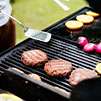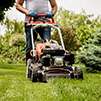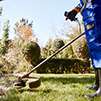We talk about the holiday season being a big time of distraction when one is focused on a bunch of other things where safety may not always be top of mind. However, the summer can be a big distraction too. There’s a lot of things that we do in our non-work lives during the summer that can get us hurt and affect our job. Besides being outside in the nicer weather and longer daylight in the evenings, there are other day and evening functions, weekend outings, and family vacations. There’s additional outside work to be done such as yardwork, grilling or playing outside in the weather. The following are areas of summer safety you need to be on the lookout for.
Note: if you like this Summer Safety article, sign up today for our free safety toolbox topic sheets which are delivered to your inbox every other Monday. We cover safety both at work and at home.
Grilling
 Grill outside, away from structures. Make sure your grill is stable on a flat surface so that it can’t be tipped over. Keep the grill clean and wait for it to cool before you clean it. Check for propane leaks on your gas grill, and if you’re using charcoal, wait for the coals to completely cool before you dispose of them. Always dispose coals into a metal container. If the flame goes out on your grill, turn off the grill AND turn off the gas, then wait 5 min. before relighting. If you use a charcoal grill, only use charcoal starter fluid. If the fire starts to go out, don’t add any starter fluid or any other flammable liquids to the fire.
Grill outside, away from structures. Make sure your grill is stable on a flat surface so that it can’t be tipped over. Keep the grill clean and wait for it to cool before you clean it. Check for propane leaks on your gas grill, and if you’re using charcoal, wait for the coals to completely cool before you dispose of them. Always dispose coals into a metal container. If the flame goes out on your grill, turn off the grill AND turn off the gas, then wait 5 min. before relighting. If you use a charcoal grill, only use charcoal starter fluid. If the fire starts to go out, don’t add any starter fluid or any other flammable liquids to the fire.
Mowing and Weed Trimming
On riding mowers, put the mower into neutral before startup and shutdown and make sure the transmission is out of gear and the mower blade clutch is disengaged before startup. Disengage the blade when you’re riding over pavement, sidewalks, and gravel. Keep the mower in gear and slow down when working on slopes and avoid mowing on slopes of angles of more than 15 degrees. Remove the key when not using the mower. Stay 5 ft. away from ditches, embankments, retaining walls, culverts or similar where you could roll over. Never remove roll over protection devices. If mowing near bodies of water, establish a safety zone to make sure you stay at a safe distance.
 For walk-behind mowers, rotary blades underneath the mower can rotate at 200 mph. Keep your hands and feet away from the blade area when it’s running. Never remove installed safety guards such as directional flaps or shielded discharge outlets or bypass safety shut down devices such as clutch handles or switches that stop the blade as soon as you let go. Mow back and forth along the side of a steep hill, never up and down the slope.
For walk-behind mowers, rotary blades underneath the mower can rotate at 200 mph. Keep your hands and feet away from the blade area when it’s running. Never remove installed safety guards such as directional flaps or shielded discharge outlets or bypass safety shut down devices such as clutch handles or switches that stop the blade as soon as you let go. Mow back and forth along the side of a steep hill, never up and down the slope.
Did you know that 1/3 of emergency room injuries from weed trimmers are eye-related, so wear your safety glasses. Bring the engine to speed before cutting. Cut away from yourself and when not cutting, run the engine at idle speed. Some types of trimmers may let out more string than you think and cause it to strike you unexpectedly so monitor string length. Before refueling a gas-powered trimmer, place it on the ground and allow the engine to cool. Keep people and pets at least 60 ft. away and stop if you’re approached. Use both hands when operating.
to cool. Keep people and pets at least 60 ft. away and stop if you’re approached. Use both hands when operating.
Before servicing your mower or your trimmer, always unplug an electric tool or shut down a gas-powered machine/tool before servicing, cleaning, inspecting, or adjusting it. Use the proper fuel and oil and be careful when always refuel when the engine is cool. Don’t service a gas-powered engine inside a storage shed as you could be overcome by carbon monoxide. Turn the power off and disconnect spark plug wires before cleaning, inspecting, and servicing and never touch the spark plug with your hand or a tool when the mower is operating.
Poison Ivy, Oak and Sumac
 Get familiar with the difference between these plants and how to spot them. Remember, leaves of three, let them be! For rashes use a cold compress, calamine lotion, non-prescription hydrocortisone cream, or an antihistamine to ease itching. You can also use other non-traditional treatments such as wrap dipped in apple cider vinegar. Call your doctor if the rash is near your eyes or covers a large part of your body.
Get familiar with the difference between these plants and how to spot them. Remember, leaves of three, let them be! For rashes use a cold compress, calamine lotion, non-prescription hydrocortisone cream, or an antihistamine to ease itching. You can also use other non-traditional treatments such as wrap dipped in apple cider vinegar. Call your doctor if the rash is near your eyes or covers a large part of your body.
Bees, Wasps, Spiders, Ants, Ticks, etc.
Before performing work in an area, take a site survey to look for any hazards including bees and wasps. Avoid attracting them by wearing light colored clothes and avoid perfumes or cologne. Do not swat and wave wildly when they approach, instead use a gentle pushing or brushing motion to deter them. Wear long sleeves and pants and be cautious about walking in high grass or brush, a good hangout for ticks. Watch where you walk, stand and sit. Fire ants like to mound under tall grass and brush. Before picking something up, kick it before you pick it.
Bicycles and Scooters
Make sure you wear helmets and use other safety gear when riding such as high visibility or reflective clothing, shoes (not flip flops or sandals). Make sure your bikes don’t have broken reflectors and make sure the light works. Check tires for air and bring extra safety equipment such as a first aid kit and extra tires if you’re going to do trail riding . Make sure your wheels, seat and handlebars are tight and that your brakes work.
Swimming
 Never swim alone, and always supervise children. Open water prevents a number of different hazards that pools don’t. These include limited visibility, depth changes, uneven surfaces, unknown objects that can be stepped on, and currents and undertow. Enter the water feet first to prevent head injury. This includes using water slides. Never dive into water that’s less than 8 ft. deep. Be on the lookout for maintenance issues around the swim area. Be alert of wet floors, sharp edges, broken glass, exposed bolts, broken ladders, broken railings and clear markings of water depth. If you find yourself struggling or accidentally fall in, float to live. Try not to panic as calmness will save you. Lean back and use your arms and legs to keep you afloat with gentle movements. Once you’re calm your breathing is controlled, then call for help or swim to safety. Don’t let your dog swim without supervision. While many dogs know how to swim, some can easily tire out.
Never swim alone, and always supervise children. Open water prevents a number of different hazards that pools don’t. These include limited visibility, depth changes, uneven surfaces, unknown objects that can be stepped on, and currents and undertow. Enter the water feet first to prevent head injury. This includes using water slides. Never dive into water that’s less than 8 ft. deep. Be on the lookout for maintenance issues around the swim area. Be alert of wet floors, sharp edges, broken glass, exposed bolts, broken ladders, broken railings and clear markings of water depth. If you find yourself struggling or accidentally fall in, float to live. Try not to panic as calmness will save you. Lean back and use your arms and legs to keep you afloat with gentle movements. Once you’re calm your breathing is controlled, then call for help or swim to safety. Don’t let your dog swim without supervision. While many dogs know how to swim, some can easily tire out.
Pulling Trailers
Choose the right tow vehicle and trailer for the load. Review the tow capacity and ensure it’s capable of handling the weight of the trailer and what you’re going to be towing on it. Exceeding the capacity can severely affect handling, brakin g and damage your vehicle’s suspension. Check the hitch for the maximum trailer and maximum tongue weights it can safely support. Make sure you have the proper hitch ball for the trailer. Incorrectly sized hitch balls are the #1 cause of trailer accidents. When hauling loads, 60% of the load on the trailer should be placed on the front half of the trailer, with a tongue weight of 10-15% of the total weight that’s loaded on the trailer. Ensure weight is evenly distributed on the left and right sides of the trailer. Straps are critical — broken or cheap straps can fail fast. Use ratchet straps for anything heavier than an average person and use more than one strap in case one comes loose. The working load of the strap should be more than the weight of what you’re hauling. Check your tires on both the vehicle and the trailer and make sure your lights work before you leave. Take spare bulbs and fuses with you. Check your brakes and make sure the breakaway cable is properly attached to your tow vehicle. Carry spare parts such as at least one trailer spare tire as well as extra wheel bearings and hubs.
g and damage your vehicle’s suspension. Check the hitch for the maximum trailer and maximum tongue weights it can safely support. Make sure you have the proper hitch ball for the trailer. Incorrectly sized hitch balls are the #1 cause of trailer accidents. When hauling loads, 60% of the load on the trailer should be placed on the front half of the trailer, with a tongue weight of 10-15% of the total weight that’s loaded on the trailer. Ensure weight is evenly distributed on the left and right sides of the trailer. Straps are critical — broken or cheap straps can fail fast. Use ratchet straps for anything heavier than an average person and use more than one strap in case one comes loose. The working load of the strap should be more than the weight of what you’re hauling. Check your tires on both the vehicle and the trailer and make sure your lights work before you leave. Take spare bulbs and fuses with you. Check your brakes and make sure the breakaway cable is properly attached to your tow vehicle. Carry spare parts such as at least one trailer spare tire as well as extra wheel bearings and hubs.
Camping
Make your camp before dark and learn the terrain while it’s still light. Give yourself 2 hours of daylight for setup. Take a good flashlight, check your equipment that it’s in good working order before you leave and pack emergency  signaling devices, emergency supplies and a first aid kit. Think about your footing and be alert to slippery areas. Watch for low hanging branches and take extra caution near cliffs, outcroppings, hills, and water edges. No matter how clear a stream looks, it’s likely to contain waterborne parasites & microorganisms, so pack your own water. Make sure your fires are always attended, cannot be spread laterally or vertically (used a grill or stone surface) and drown it with water to put it out. Embers buried deep in the pile can reignite later. Be cautious when using a propane stove. Tents should be flame retardant and far enough away from the campfire. Wear sunscreen, hats, sunglasses and drink plenty of water. Pack carbohydrate-energy bars, granola candy or fruit for instant energy on your hikes.
signaling devices, emergency supplies and a first aid kit. Think about your footing and be alert to slippery areas. Watch for low hanging branches and take extra caution near cliffs, outcroppings, hills, and water edges. No matter how clear a stream looks, it’s likely to contain waterborne parasites & microorganisms, so pack your own water. Make sure your fires are always attended, cannot be spread laterally or vertically (used a grill or stone surface) and drown it with water to put it out. Embers buried deep in the pile can reignite later. Be cautious when using a propane stove. Tents should be flame retardant and far enough away from the campfire. Wear sunscreen, hats, sunglasses and drink plenty of water. Pack carbohydrate-energy bars, granola candy or fruit for instant energy on your hikes.
Free Safety Toolbox Sheets
We send a toolbox topic every other Monday morning to your email inbox for free. It’s our way of supporting safety in the workplace and at home. Sign up today!